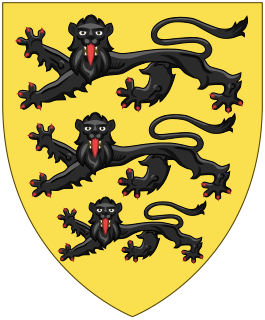
The Hohenstaufen dynasty, also known as the Staufer, was a noble family of unclear origin that rose to rule the Duchy of Swabia from 1079, and to royal rule in the Holy Roman Empire during the Middle Ages from 1138 until 1254. The dynasty's most prominent rulers – Frederick I (1155), Henry VI (1191) and Frederick II (1220) – ascended the imperial throne and also reigned over Italy and Burgundy. The non-contemporary name of 'Hohenstaufen' is derived from the family's Hohenstaufen Castle on the Hohenstaufen mountain at the northern fringes of the Swabian Jura, near the town of Göppingen. Under Hohenstaufen rule, the Holy Roman Empire reached its greatest territorial extent from 1155 to 1268.
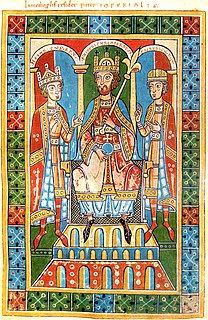
Year 1155 (MCLV) was a common year starting on Saturday of the Julian calendar.

Frederick Barbarossa, also known as Frederick I, was the Holy Roman Emperor from 1155 until his death 35 years later. He was elected King of Germany in Frankfurt on 4 March 1152 and crowned in Aachen on 9 March 1152. He was crowned King of Italy on 24 April 1155 in Pavia and emperor by Pope Adrian IV on 18 June 1155 in Rome. Two years later, the term sacrum ("holy") first appeared in a document in connection with his empire. He was later formally crowned King of Burgundy, at Arles on 30 June 1178. He was named Barbarossa by the northern Italian cities which he attempted to rule: Barbarossa means "red beard" in Italian; in German, he was known as Kaiser Rotbart, which means "Emperor Redbeard" in English. The prevalence of the Italian nickname, even in later German usage, reflects the centrality of the Italian campaigns to his career.

Year 1190 (MCXC) was a common year starting on Monday of the Julian calendar.

The Third Crusade (1189–1192) was an attempt by three European monarchs of Western Christianity to reconquer the Holy Land following the capture of Jerusalem by the Ayyubid sultan Saladin in 1187. For this reason, the Third Crusade is also known as the Kings' Crusade.

The Lombard League was a medieval alliance formed in 1167, supported by the popes, to counter the attempts by the Hohenstaufen Holy Roman emperors to assert influence over the Kingdom of Italy as a part of the Holy Roman Empire. At its apex, it included most of the cities of Northern Italy, but its membership changed with time. With the death of the third and last Hohenstaufen emperor, Frederick II, in 1250, it became obsolete and was disbanded.
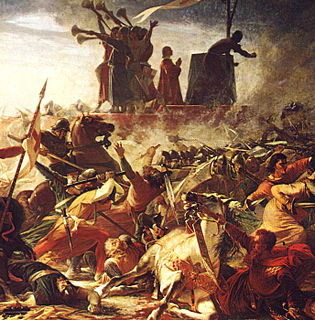
The Battle of Legnano was a battle between the imperial army of Frederick Barbarossa and the troops of the Lombard League on May 29, 1176, near the town of Legnano in present-day Lombardy, in Italy. Although the presence of the enemy nearby was already known to both sides, they suddenly met without having time to plan any strategy.

Tortona is a comune of Piemonte, in the Province of Alessandria, Italy. Tortona is sited on the right bank of the Scrivia between the plain of Marengo and the foothills of the Ligurian Apennines.
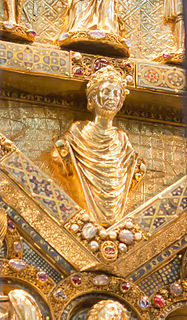
Rainald of Dassel was Archbishop of Cologne and Archchancellor of Italy from 1159 until his death. A close advisor to the Hohenstaufen emperor Frederick Barbarossa, he had an important influence on Imperial politics, mainly in the Italian conflict of Guelphs and Ghibellines.
The siege of Viterbo was fought in 1243 between the Holy Roman Emperor Frederick II and the rebellious city of Viterbo, 50 km north of Rome.
The siege of Faenza occurred from August 1240 to April 14, 1241, during the course of the wars of the Guelphs and the Ghibellines. In this military confrontation, the Holy Roman Emperor Frederick II aggressively laid siege to the town of Faenza and successfully captured the city.

The Battle of Parma was fought on 18 February 1248 between the forces of Holy Roman Emperor Frederick II and the Lombard League. The Guelphs attacked the Imperial camp when Frederick II was away. The Imperial forces were defeated and much of Frederick's treasure was lost.

Volpedo is a comune (municipality) in the Province of Alessandria in the Italian region Piedmont, located about 100 kilometres (62 mi) east of Turin and about 30 kilometres (19 mi) east of Alessandria.

Corbetta is a comune (municipality) in the Metropolitan City of Milan in the Italian region Lombardy.
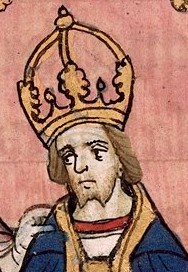
Henry VII, also known as Henry of Luxembourg, was Count of Luxembourg, King of Germany from 1308 and Holy Roman Emperor from 1312. He was the first emperor of the House of Luxembourg. During his brief career he reinvigorated the imperial cause in Italy, which was racked with the partisan struggles between the divided Guelf and Ghibelline factions, and inspired the praise of Dino Compagni and Dante Alighieri. He was the first emperor since the death of Frederick II in 1250, ending the Great Interregnum of the Holy Roman Empire; however, his premature death threatened to undo his life's work. His son, John of Bohemia, failed to be elected as his successor, and there was briefly another anti-king, Frederick the Fair, contesting the rule of Louis IV.

Barbarossa is a 2009 Italian English-language film set primarily in northern Italy during the late 12th century. Despite the film's title, Friedrich "Barbarossa" features only as a supporting character in this film, which is primarily concerned with the struggle of the Lombard League, which struggled to maintain independence from the Holy Roman Empire, led by the legendary Guelph warrior Alberto da Giussano.

The siege of Crema was a siege of the town of Crema, Lombardy by the Holy Roman Empire from 2 July 1159 to 25 January 1160. The Cremaschi attempted to defend their city from the Germans, but were eventually defeated by Frederick Barbarossa's men. Frederick seized Milan in 1162, shortly after he took Crema. These events started the wars of Guelphs and Ghibellines, leading to the formation of the Lombard League, a league of northern Italian communes allied against the emperor, supported by the Pope.

The siege of Roses or Siege of Rosas from 7 November to 5 December 1808 saw an Imperial French corps led by Laurent Gouvion Saint-Cyr invest a Catalan and Spanish garrison commanded by Peter O'Daly. After a siege lasting a month in which the haven and town of Roses was captured and the nearby Trinity Castle invested by over 13,000 French and Italian infantry, artillery and cavalry with heavy siege trains on the hills above, the Citadel was surrendered to the Napoleonic forces. Roses (Rosas) is located 43 kilometres (27 mi) northeast of Girona, Catalonia, Spain. The action occurred during the Peninsular War, part of the Napoleonic Wars.

The War of the Keys (1228–1230) was the first military conflict between Frederick II, Holy Roman Emperor, and the Papacy. Fighting took place in central and southern Italy. The Papacy made strong gains at first, securing the Papal States and invading the Kingdom of Sicily, while Frederick was away on the Sixth Crusade. Upon his return, he defeated the papal forces, forcing Pope Gregory IX to begin peace talks. After drawn-out negotiations, the treaty of San Germano terminated the conflict with no territorial changes.
The Milan–Lodi War was a conflict fought in the early 12th century between the Lombard comuni of Milan and Lodi, resulting in the defeat and destruction of the latter.


















